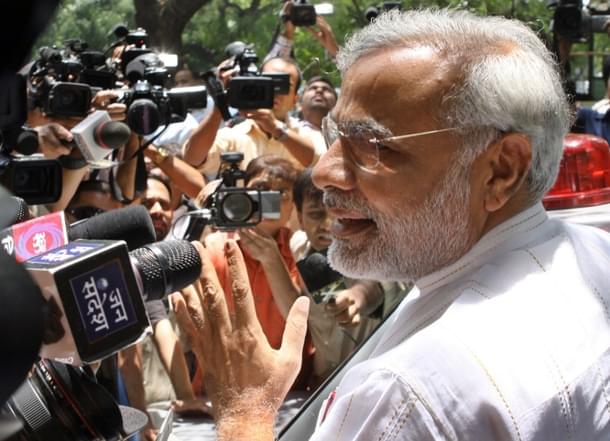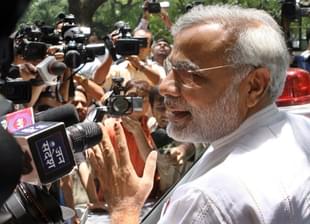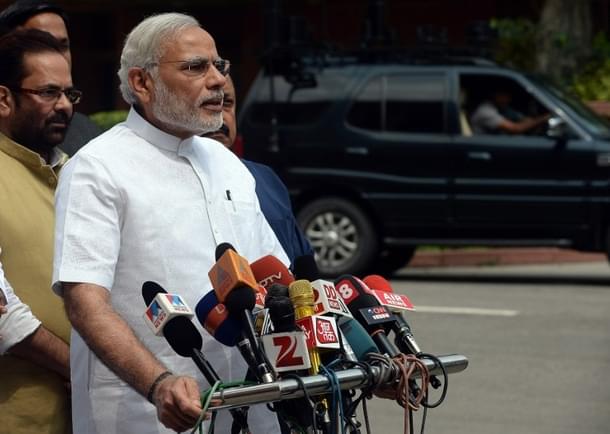Politics
You’ve Lost The Media Plot, Mr Modi; Time To Get It Back
Seetha
Nov 11, 2015, 07:01 PM | Updated Feb 24, 2016, 04:24 PM IST
Save & read from anywhere!
Bookmark stories for easy access on any device or the Swarajya app.


When it comes to a media strategy, Narendra Modi has scrapped the old system, but has not replaced it by anything new.
The takeaways from the Bihar election results for Prime Minister Narendra Modi are many – the top one being that he should now devote more bandwidth to bringing back the development focus that swept him to power.
Something else needs equally top billing. Modi and the BJP need to have a public relations and communications strategy in place. This is an area in which the Modi government has completely lost the plot, never mind Arun Shourie’s charge that it is managing the headlines more than the economy.
Yes, Modi is a great marketer, fond of hyping up even piddly achievements with cleverly worded acronyms and dazzling numbers. Yes, some claims are much taller than reality. Yes, there have been stray cases of articles criticising some of his favourite ministers being pulled off news websites. But can anyone seriously assert that his government is managing the media effectively?
The Modi government has significant achievements under its belt, especially on the economic front. And yet, barring the business press and some overtly pro-BJP/Modi media outlets, the impression conveyed by most publications and news channels is that of a clueless government, which is efficient only in pursuing a communal agenda.
This is what happened during Atal Behari Vajpayee’s tenure – every stray communal incident was played up as a sign of the Hidden Agenda. But Vajpayee had not riled the media as much as Modi has, and he was often portrayed as being a helpless victim of Hindutva hardliners. Modi is getting no such sympathy and his barely disguised contempt for the media is not exactly helping matters. Nor is the fact that the party also does not appear to have an effective media team after stalwarts like Arun Jaitley, Nirmala Sitharaman, Ravi Shankar Prasad, Prakash Javadekar and Piyush Goyal joined the government. In fact, the party appears to be making things worse, unable to either put out an effective response to controversies or to get loose-tongued party members to keep silent. As a result, the party often ends up taking responsibility (and not just getting blamed) for even actions of lone lunatics who are not associated with it at all.

The media strategy has to happen at both the government and party levels. Both need to take basic communications lessons from the corporate sector, especially when faced with controversies. What gave wind to the allegations by the Modi detractors brigade about growing intolerance? The fact that Modi and party president Amit Shah remained silent on the murder of writers, church attacks, provocative statements by his ministers, the Dadri lynching incident and the burning of two Dalit children in Haryana.
Arguing that the prime minister cannot be speaking on every issue is downright silly when his opponents are not letting go of any controversy – manufactured or otherwise – to get at him. Chief executives of companies rarely meet the media except in controlled conditions. The corporate communications departments and public relations agencies handle all media queries and outreach. But when a controversy erupts, they immediately make themselves available or at least put out a statement – sometimes even an apology – and flood journalists with information that is favourable to them.
Take the recent controversy over Maggi noodles. The company did not trash the test reports or blame the controversy on its competitors. It withdrew stocks from the market and destroyed them (never mind that its critics said this was an admission of guilt) and moved the courts for redress. Armed with an acquittal from the courts and laboratory clearance for its samples, it is making a comeback.
Several years back, a report about high levels of pesticides in soft drinks set off a scare. Otherwise bitter rivals Coke and Pepsi immediately joined hands and went on a media outreach overdrive, putting out counter reports, holding joint press conferences and making the CEOs available for interviews. Through all that, they did not question anyone’s integrity or impute motives (as the BJP tends to do with its political and ideological rivals; this is something that should be outsourced to credible ideological fellow travellers). Instead the message was simple and clear (as in the case of Maggi) – we will not do anything to harm people’s health. Controversy over, the top officials went back into their impenetrable shells.
Modi appears to do just the opposite. He is over-active on Twitter even on inane issues, but goes completely mum when a controversy breaks out. Remaining stubbornly silent and letting party hotheads make provocative statements and making a bland statement after the silence has been widely condemned only makes him look reactive, not pro-active; it gives the impression that it is the other side that is setting the agenda of the discourse.
When ministers/party members shoot their mouths off, statements need to be put out immediately saying this is not the official view of the government/party. Remaining silent only reinforces his opponents’ charge that these are actually the official views. Calling the errant members later for a stage-managed dressing down after a huge uproar means little, if anything at all.

There is a lesson to be learnt (and drilled into ministers/party members), this time from Bollywood – the effective use of `no comment’. Most recent cases of foot-in-the-mouth disease have been the result of people responding to journalists’ pestering questions. Journalists are going to trap people into saying things; we will seek out motormouths; that is our job. `No comment’ should be the standard response to such questions, whatever the provocation. Or, `the party/Prime Minister/concerned minister has spoken, I have nothing to add’.
The Press Information Bureau (PIB) was once the first point of contact for journalists as well as of putting the government point of view across and damage control. Successive governments have allowed the PIB to atrophy and it has become little more than an agency that sends out invites for press conferences and issue press releases. Ministers have preferred to sidestep PIB officials and develop their own equations with journalists through their personal staff. This is not necessarily a bad thing, except that a minister’s personal staff may not always have media management skills. PIB officials get demotivated and are not effective in countering negative fallouts.
This government has done little to reverse the trend, barring prodding PIB to be active on social media. But this is nothing more than putting out announcements and congratulatory tweets. It is important to use the PIB creatively to highlight the government’s achievements and empower PIB officials to be effective spokespersons, arming them with information and encouraging officials to open up to them. PIB should be made as effective as the internal corporate communications departments of companies, the first line of information and defence. This also takes the pressure off the Prime Minister or individual ministers.
Senior officials must be encouraged to hold regular press conferences to brief journalists and answer queries. The finance ministry has made a start and other ministries need to follow suit. Unfortunately, the message from the top is that this government is not keen on engaging with the media and this has led to officials becoming inaccessible even to journalists who try to get the ministry point of view before running a negative story.
Modi clearly does not like engaging with journalists, preferring to deal with the public through tweets. Even his predecessor did not interact with journalists. But he, like Vajpayee before him, had an official spokesperson in the PMO who would meet journalists regularly, brief them on what was happening, provide information for stories or effectively kill negative stories. Modi has his trusted Jagdish Thakkar as public relations officer but he does not seem to be playing the role that Ashok Tandon did for Vajpayee or Sanjaya Baru and Harish Khare did for Manmohan Singh. Modi may have his reasons for dismantling the earlier system, which undoubtedly encouraged an unhealthy cronyism, but he needs to replace it with a more effective one, given that the English language media is largely hostile to him.
Engaging with journalists should absolutely not mean a return to free junkets in the form of overseas trips with the Prime Minister and other ministers, where the government picked up the tab for the airfare and other expenses. This meant that the government of the day could pick and choose the media houses and individual journalists it wanted to patronise; jockeying with the government was a common affair.
But getting journalists to travel with the Prime Minister gave the government an advantage – it could get its point of view across in informal chats and apparently spontaneous briefings and even control stories. Modi has scrapped the old system, but has not replaced it by anything new. Why not let journalists travel with the Prime Minister but not for free, as is done in some western countries? Anybody whose expenses are paid for by his employers can come on board; that will end patronage, lobbying and charges of favouritism. And the government can manage the headlines far more effectively than it is doing now. It might as well live up to the name Shourie has given it.
Seetha is a senior journalist and author





